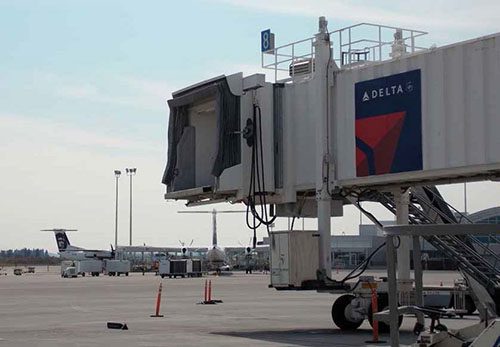 With about 2 million square feet of interior space, nine separate buildings and 3,000+ pieces of equipment under its purview, the facilities maintenance department at Spokane International Airport in Washington (GEG) has a lot of ground to cover. Its wide variety of duties – from preventive maintenance on the HVAC system and snow removal to unclogging restroom toilets and changing baggage belts – used to be managed on a rudimentary whiteboard. Assignments were listed and then crossed off or erased.
With about 2 million square feet of interior space, nine separate buildings and 3,000+ pieces of equipment under its purview, the facilities maintenance department at Spokane International Airport in Washington (GEG) has a lot of ground to cover. Its wide variety of duties – from preventive maintenance on the HVAC system and snow removal to unclogging restroom toilets and changing baggage belts – used to be managed on a rudimentary whiteboard. Assignments were listed and then crossed off or erased.
About nine years ago, though, the department computerized its operations and overhauled its recordkeeping and strategic approach. Since the dramatic change, the department has taken on maintenance of GEG's baggage handling system and 14 loading bridges – without adding more employees to the 11-member team.
 "I like to run lean and efficient," explains Maintenance Superintendent Ken Landrus. "We couldn't do all we do, the way we do it, without our computer system."
"I like to run lean and efficient," explains Maintenance Superintendent Ken Landrus. "We couldn't do all we do, the way we do it, without our computer system."
After transitioning to a computerized maintenance management system, Landrus realized the department had previously over-maintained some equipment and undermaintained others. "The most common scenario was one technician performing a task without crossing it off on the board – usually because he got called away for something else on his way back to the office," Landrus notes. "Then another technician would come right behind him and perform the same work again."
Now, GEG has a full maintenance history on all of its equipment and systems – from temperature control units to the locks on bathroom doors. "The system helps us flag repetitive problems," he relates. "If we've had three maintenance calls about an exhaust fan in the fire station in one month, maybe the blades need to be balanced or maybe the bearings are shot. The data helps us know where to look deeper."
Predictable Does not Equal Boring
The airport's system – ProTeus from Eagle Technology – also allows technicians to log condition reports that facilitate follow-up work. Belts, for instance, often lengthen after a few days of operation. The system allows technicians to leave a note that triggers a subsequent check. Additional work completed during routine inspections such as "put in new sprocket" can also be recorded to avoid premature part replacement. Previously, tasks were simply marked "complete" or remained active on the board.
Keeping up with preventive maintenance has obvious lifecycle and financial advantages. "We've saved huge money on door locks alone," Landrus relates. "It's nothing for them to cost $800 each, and they last much longer with proper maintenance. Often, all they need is to be lubed." Timely maintenance for security doors adds value.
 GEG, however, has been able to take the process one step further. "With all the information we've gleaned, we've been able to transition from preventive maintenance to predictive maintenance," Landrus explains. "We know a chop door is good for 20,000 cycles and certain bag belts are good for six months; so we prepare for replacements when we're getting close. We know just when drum motors will go bad, so we have them on hand."
GEG, however, has been able to take the process one step further. "With all the information we've gleaned, we've been able to transition from preventive maintenance to predictive maintenance," Landrus explains. "We know a chop door is good for 20,000 cycles and certain bag belts are good for six months; so we prepare for replacements when we're getting close. We know just when drum motors will go bad, so we have them on hand."
Landrus is particularly pleased with how the department maintains the airport's loading bridges and baggage handling system. "We have very little downtime," he reports. "With the loading bridges, we run lower cycle times than many other locations and have less up and down movement and steering, due to a steady stream of narrow body jets such as 737s, A320s and 757s rather than a broader mix of different aircraft."
A variety of trusted sources, including TSA personnel, have told Landrus that GEG's baggage handling system is the best-maintained system in the industry. "It's seven to eight years old, but people say it looks and runs like a one-and-a-half-year-old system," he reports.
Switching to a computerized system, cautions Landrus, isn't a simple plug-and-play installation or overnight conversion. Creating a database of maintenance schedules from original equipment manufacturers took several years, and is still an ongoing process. 
"Many of their procedures are based on the first year of operation for warranty purposes, or were developed based on 24/7 operation," Landrus explains. "If we followed those guidelines throughout the lifecycle, we'd be overmaintaining. You have to apply common sense to the process."
Team members also verified the system's compatibility with GEG's Johnson Controls building management/control system and developed a numbering system for the equipment.
Department personnel also entered notes in the system to facilitate regular procedures. Certain motor bearings, for instance, require specific amounts of grease at specific calendar intervals. "We used a postal scale to determine how many pumps of the grease gun it took to apply the correct amount," explains Landrus. "Now, for instance, we know that a 1-inch bearing gets two pumps of grease once a year. We're not going in unnecessarily to check, and we know we have the right amount."
The Value of Knowing
The enhancements and efficiencies GEG gained by transitioning to a computerized maintenance management system are representative of what most airports could experience, notes Harry Kohal, vice president of Eagle Technology.
"It's about knowing exactly what equipment you have and getting your arms around the huge job of maintaining it all," says Kohal.
 He also highlights the technology's role for in-house departments: "When management decides maintenance is costing too much, they outsource it and often end up with ‘sick buildings' that cost them more in the long run. When you have data about how long maintenance should take and how long it's taking, it's easier to justify staffing levels."
He also highlights the technology's role for in-house departments: "When management decides maintenance is costing too much, they outsource it and often end up with ‘sick buildings' that cost them more in the long run. When you have data about how long maintenance should take and how long it's taking, it's easier to justify staffing levels."
Using system like ProTeus, which merges asset and maintenance management, airports can get more lifecycle out of what they own, he adds.
Like Landrus, Kohal emphasizes the value of preventive maintenance. "Interrupt maintenance" is historically documented to be 50% more costly than regularly scheduled maintenance, he notes.
When issues of security or liability are involved, the stakes are raised even higher. Kohal recently encountered a damaged wall plug when traveling through a mid-size airport. "I went to recharge my phone, and a loose metal cover created an arc," he relates. "I wasn't hurt and my equipment wasn't damaged, but the airport is exposing itself to a lot of unnecessary liability."
Regular inspection of assets, as prompted and tracked by a computerized maintenance management system, can help airports correct such defects immediately. "Anything the public has contact with, from people movers to carpeting, has to be monitored closely. What's fine in the morning can be a disaster waiting to happen by evening," he cautions.
Airports can expect a 5% to 20% reduction in maintenance costs after the first year of using the ProTeus system, reports Kohal. "ISO-style best practices deliver productivity gains," he explains.
You're It
On the playground, getting tagged is a big disappointment. At an increasing number of airports, it's a big plus.
AVRamp, by I.D. Systems, helps manage ground service vehicles at Dallas/Fort Worth International Airport via wireless transponder tags. In addition to collecting run-time information for usage analysis and maintenance scheduling, the system requires drivers to swipe their identification badge to turn on the ignition.
On the safety front, the system provides real-time tracking and geo-fencing capabilities to help keep ground service vehicles out of restricted areas. Impact sensors automatically report collisions to supervisors.
While AVRamp uses GPS and radio frequency identification technology to collect and transmit data outside terminals, Tyco Integrated Security (formerly branded as ADT Commercial Security) takes a different approach with its real-time location system products for indoor applications.
"Most airports have 802.11 infrastructure for their Wi-Fi service," explains Paul Fisher, senior government account manager at TycoIS. "We ride on the backbone of that existing infrastructure, which can substantially lower start-up costs."
Fisher is currently working with a large U.S. airport in applying the technology to its fleet of wheelchairs. "Tracking where wheelchairs were and getting them to the right gates used to take lots of time," he explains. "Employees were literally walking around the terminal searching for available chairs."
With small locator tags affixed to each chair, staff members now know where each is and which is closest to the gate in need. "Passengers are happier, because they're not waiting, and airport employees are freed up for other duties," relates Fisher.
Locators that track motion cost $50 to $150 per unit, depending on the quantity of tags purchased and the value of the assets they're affixed to, he notes. Passive barcode stickers are even less expensive – sometimes pennies per unit, Fisher adds. They don't provide as much information and require a reader, which costs around $1,500, to collect data.
Barcode tags can be used to track maintenance performed on airport systems. If, for instance, HVAC filters are supposed to be changed four times per year but airport officials suspect that's not getting done, they can install barcodes inside the system near the filters and require contractors to scan them when they change the filters. "The information from the scanner verifies that the service was completed, logs how long it took to double-check a contractor's estimate and speeds the ordering process for replacement filters," explains Fisher.
He sees a myriad of other potential applications for TycoIS technology: tags on Automatic External Defibrillators to prevent theft and speed response time of emergency responders to the correct location; on snow removal or grass cutting equipment to coordinate activity and enhance efficiency; even on janitorial staff to help dispatch the closest employee and track how fast service calls are answered.
"The possibilities for the technology are endless," notes Fisher.
Southwest Airlines recently incorporated Sentry tracking units into its cargo service. For an extra fee, shippers can include a 12-ounce wireless tracking device inside their shipments. The device allows customers to monitor movement of their goods on a map, much the same way flight trackers follow the progress of passenger flights. Beyond location, however, the device also monitors the temperature, humidity, pressure and shock environment inside the shipping container.
LaserShip, a company that arranges delivery of tissue samples, organs, blood and other extremely time-critical items, was the first company to begin using Southwest's new Cargo Companion service.
Outside Interests
Karen Mongelli, vice president of government sales and account management at Webtech Wireless, sees the airport sector as a largely untapped but ideal market for GPS-based vehicle tracking systems and telematics that gather operating data from them.
"Airports have a lot of equipment in a small geographic area," Mongellli explains, contrasting them with large municipalities that also use the technology. "AVLs (automated vehicle locators) help manage driver behavior and provide valuable information about usage."
On winter ops equipment, for instance, sensors can collect data about the amount of salt or liquid being spread, time that brooms or plows spend down and up, and other general operating data such as miles per hour. "It tells you a lot," notes Mongelli. "If sweepers are traveling too fast, they're ineffective. If spreaders are using too much salt, material is being wasted; if they're not applying enough, time is wasted, and that's not cost-effective either."
Operational data facilitates proactive scheduling of routine maintenance such as oil changes and broom replacements. It can also be used to compare the performance of two contractors providing the same services, she adds.
Some airports use real-time tracking to enhance fleet coordination and asset deployment. "Airport-specific maps show users the precise location of their equipment," Mongelli explains. "Beyond knowing precisely where the asset is located, they can watch them move and make operational decisions from behind a desk. Information is updated every three seconds."
Cost ranges from $1,200 per unit for fully installed equipment that reports a rich amount of data to $250 for "slap and track" user-installed sensors, she reports. The latter, she explains, can be used to track when outside construction vehicles are on or off airport property or other relatively simple activities.
Webtech also provides real-time reporting as a "hosted data provider" for about $50 per month; prices vary according to reporting frequency and data volume.
Other Options
Tagging devices, radio frequency identification sensors and maintenance tracking software are just three examples of technologies airports can use to minimize costs and maximize productivity. Additional options are continually being developed.
"Airports are technology driven," notes Mongelli. "We see an increase in tracking and performance reports becoming a priority."
It's not, however, an end-all, be-all. "Sure, it saves us a lot of time and it definitely makes us more efficient," comments Landrus. "But it's a tool. Having employees who can think for themselves and think out of the box is my biggest focus. Lots of people get hung up on numbers and data. In the end, airport systems are like any other man-made physical equipment. Eventually, they will break down, sometimes despite the best preventive maintenance. That's when you need self-starters with the right skills and tools."
Even some system providers acknowledge technology's limits. "It's not a magic fix," cautions Eagle Technology's Kohal. "Senior management can't buy a software package, plug it in and expect all their maintenance issues to disappear. You need qualified people to ensure a return on that investment."


